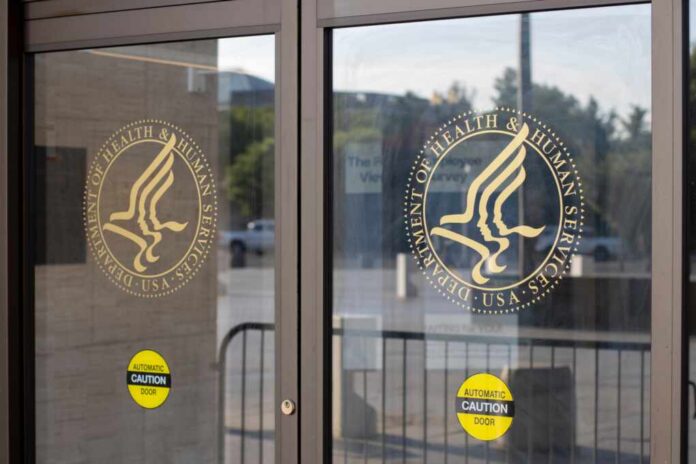
HHS budget cuts slash 20,000 jobs and 35% of contract funding, raising concerns about how the department will continue to provide essential health services to America’s most vulnerable.
At a Glance
- The Department of Health and Human Services is cutting around 20,000 jobs, including 10,000 through layoffs and 10,000 through retirements and buyouts
- Secretary Robert F. Kennedy Jr. is requiring all HHS divisions to reduce contract spending by 35%
- Affected agencies include the CDC, FDA, NIH, and Centers for Medicare and Medicaid Services
- Critics argue these cuts threaten public health infrastructure while the administration contends they will eliminate waste and improve efficiency
Massive Workforce Reduction Across Health Agencies
The Trump administration has launched one of the most significant reorganizations of federal health services in recent memory, with Health Secretary Robert F. Kennedy Jr. directing a workforce reduction that will eliminate approximately 20,000 positions at the Department of Health and Human Services.
The cuts target several critical agencies, including the Centers for Disease Control and Prevention (CDC), Food and Drug Administration (FDA), National Institutes of Health (NIH), and the Centers for Medicare and Medicaid Services (CMS). This restructuring will reduce the department’s workforce from 82,000 to approximately 62,000 employees.
Divisions responsible for tackling HIV, minority health, injury prevention, drug approval, health insurance, and infectious disease response have all been affected by the layoffs. In some cases, entire offices have been eliminated, including the CDC’s Freedom of Information Act office and divisions focused on mining worker safety.
The Administration for Strategic Preparedness and Response, which handles public health emergencies, will be folded into the CDC, while some responsibilities may shift to a new entity called the Administration for Healthy America.
Kennedy Defends Cost-Cutting Measures
Secretary Kennedy has defended the dramatic reduction in workforce, describing HHS as “the biggest agency in government, twice the size of the Pentagon, $1.9 trillion dollars.” He has criticized the department’s effectiveness in improving American health despite its substantial budget and personnel. The health secretary has pointed to the department’s size and budget as justification for the sweeping changes, suggesting the cuts will lead to greater efficiency in operations.
“The 35% reduction in HHS contracts is a strategic initiative across all divisions of HHS, with the goal of cutting unnecessary spending, saving taxpayer dollars, and streamlining operations.”, says Andrew Nixon.
Budget experts have noted that less than 1% of the department’s $1.8 trillion budget is spent on personnel. The vast majority of HHS funds are allocated to Medicare and Medicaid, supporting healthcare for seniors and low-income Americans. These funds are distributed to hospitals, clinics, nursing homes, dialysis centers, pharmaceutical companies, and medical device makers, not to administrative overhead or bureaucracy as some have suggested.
Impact on Public Health Services
The workforce reductions have created significant disruption within health agencies. Some employees reported being refused entry to their workplaces, while others described a chaotic atmosphere as the cuts were implemented. Communications offices, including the FDA’s media affairs and drug evaluation teams, were significantly reduced, potentially impacting how health information is disseminated to the public and how drug approvals are processed.
“This is at best getting water from a stone. They seem to be on a quest to totally destroy the infrastructure of the nation’s public health system. It’s amazing that they are looking to cut the parts of our health system that give the best value for prevention and wellness.”, says Dr. Georges Benjamin.
Public health advocates and Democratic lawmakers have expressed concerns about the impact of these cuts on essential services. They argue that reducing staff in agencies responsible for disease prevention, food safety, drug approval, and healthcare oversight could jeopardize public health efforts and leave the nation less prepared for future health emergencies. Several lawmakers have demanded explanations from Secretary Kennedy regarding the reorganization and how critical functions will be maintained with reduced resources.
Contract Reductions Add to Concerns
Beyond the job cuts, HHS has mandated a 35% reduction in contract spending across all divisions. This additional belt-tightening measure affects operations beyond direct employment and could impact research, public health campaigns, and partnerships with outside organizations. Agency officials have been instructed to identify ways to continue essential functions while meeting these significant budgetary constraints.
“Every agency within HHS is committed to reducing contract expenditures by this target. These cuts are designed to ensure that every dollar is used more efficiently while continuing to focus on our core mission of improving public health and services.”, concludes Andrew Nixon.
The administration maintains that these cuts are necessary to eliminate waste and inefficiency while maintaining core health services. They argue that by streamlining operations and reducing administrative overhead, the department can better focus on its primary mission. Critics counter that the scale and scope of these reductions will inevitably affect service delivery and the nation’s ability to respond to public health threats, potentially leaving vulnerable populations at greater risk.

























